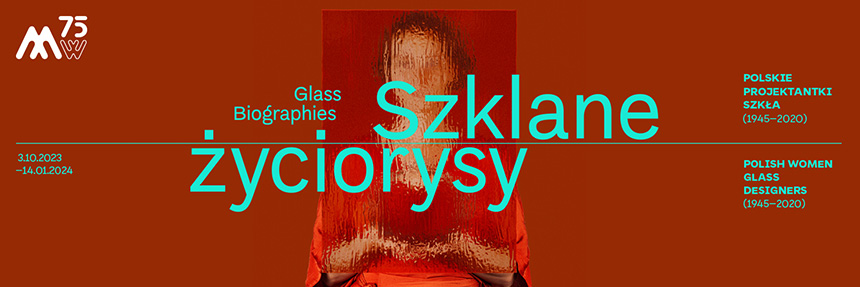During World War II (1939-1945) and its aftermath, the Polish glass industry suffered multifarious losses: many glassworks were destroyed and their qualified workforce dispersed and some important privately-owned enterprises were no longer within Polish borders, like the “Niemen” glassworks in Brzozówka which has continued to operate in today’s Belarus.

On the other hand, as Lower Silesia became part of the so-called Regained Territories, so did the region’s renowned, well-established German glassworks. Among the most important was Josephinenhütte with two glassworks at Szklarska Poręba and Piechowice (it was renamed “Julia” in 1958), Oranienhütte in Stronie Śląskie (renamed “Violetta”), and also the glassworks in Szczytna and Pieńsk. Among the Polish glassworks which continued to operate after 1945 was “Hortensja” in Piotrków Trybunalski, “Irena” in Inowrocław, and the factories in Zawiercie, Dąbrowa Górnicza, and Krosno.
On the initiative of Wanda Telakowska, a pioneering figure instrumental in animating Polish design after the war, residencies at the Lower Silesian glassworks were offered to the group of Warsaw artists, the majority of whom were associated with the ŁAD Artistic Cooperative founded in 1926: Jan Kurzątkowski, Stanisław Ptaszyński, Henryk Gaczyński, Halina Jastrzębowska, and Wanda Manteuffel. The latter two women artists are regarded as the pioneers of Polish modern utility glass design.
Although Jastrzębowska and Manteuffel had no previous experience in glassmaking and designing glass, their ŁAD background gave them the necessary versatility to adjust their method to new challenges. Initially, they focused on designing engraved decorations but soon expanded into developing new lines of glassware. Their first collaborative project was a jug and glasses set produced by the “Sudety” Glassworks in Szczytna. With the vessels’ bellies constructed of stacked segmental beefy circles, the otherwise undecorated set was strikingly original and modern while its soft forms and the jug’s exquisitely modelled handle made the practical function of pouring and consuming cold drinks truly delectable.
WANDA ZAWIDZKA-MANTEUFFEL
(1906–1994)
In 1926–1931, she studied at the Academy of Fine Arts in Warsaw where she attended classes of Miłosz Kotarbiński, Edmund Bartłomiejczyk and Władysław Skoczylas (printmaking and graphic design), Karol Tichy (ceramics), and Lucjan Kintopf (weaving). She graduated with an MFA in 1934 and joined KAGR, an association of artists specializing in advertising and graphic design. In 1935, she received a grant from the National Culture Fund and continued her education in Paris at the school of Paul Collin (1935–1937). After World War II, she joined the ŁAD Artistic Cooperative. She was a member of the Association of Polish Artists and Designers (ZPAP) and also of the Keramos Association of Ceramic Artists (from 1974).
In the first postwar years, she collaborated with the state institutions newly established to implement and improve design standards in the nationalized industries: the Department of Manufacturing, the Bureau for Supervising Aesthetic Standards in Industrial Production, and then the Institute of Industrial Design. During this period, she co-designed chandeliers for public spaces (together with Halina Jastrzębowska and Henryk Gaczyński). She also designed one of the first pressed glass sets (called Perełki, literally “small pearls”) serially produced by the “Ząbkowice” glassworks in Dąbrowa Górnicza after 1945. She also designed glassware for the “Sudety” Glassworks in Szczytna. In 1964–1979, she headed the in-house Design Studio the “Irena” glassworks in Inowrocław. From 1959, she represented the Association of Polish Artists and Designers in the Selection Committee of the Glass Industry.
In the 1950s, she designed for the Faience Factory in Włocławek and also designed textiles for the ŁAD Artistic Cooperative. Before and immediately after the war, she also illustrated children’s books. In the 1970s, she made jewelry and ceramic wares in her small ceramics studio located in ul. Walecznych in Warsaw.
HALINA JASTRZĘBOWSKA-SIGMUND
(1907–2003)
In 1934, she graduated with an MFA from the Academy of Fine Arts in Warsaw (class of Felicjan Szczęsny-Kowarski). Her family background doubtless exerted a seminal influence on the development of her artistic interests. Her father Wojciech Jastrzębowski, Rector of the Academy of Fine Arts in Warsaw, was a towering figure on the Polish art scene of the first half of the twentieth century. The co-founder of the Kraków Workshops (1913) and the ŁAD Artistic Cooperative (1926), he mentored many talented students in the 1920s and 1930s.
During the interwar period, she actively participated in artistic life as a member of the progressive BLOK Association of Artists and the ŁAD Artistic Cooperative. She pursued design in multiple fields: graphic and exhibition design, furniture and glass. In 1938–1945, she was a curator at the Museum at Rapperswil (Switzerland) where she co-founded the gallery of contemporary Polish art. She returned to Poland in 1945 and initially settled in Polanica-Zdrój where she organized ŁAD’s carpentry workshops. She also began designing for the “Józefina” glassworks (today “Julia”) in Szklarska Poręba under the auspices of the Bureau for Supervising Aesthetic Standards in Industrial Production. For several years (1949–1952), she also developed and headed the glass design programme at the State College of Fine Arts (PWSSP) in Wrocław (today the Academy of Art and Design).
In the 1950s, she returned to Warsaw where she became involved in the activities of the Association of Polish Artists and Designers (ZPAP). She also joined the faculty of the Department of Fine Arts at the University in Toruń and was consulted as an expert by the Ministry of Culture and Art. In 1964–1967, she was an in-house designer at the “Dąbrowa” glassworks at Dąbrowa near Łuków. All her designs produced during this relatively short period are noteworthy. They showcase the artist’s awareness of current stylistic trends in glass design while reflecting her skill in adapting them to the factory’s production capability and customer preferences. The three flower vases of the Prima set are stackable and thus easy to store while making an attractive decorative object. With its charming dimpled belly, the Penguin jug is a modern and interesting form recalling the restrained and functional designs of Finnish glass.